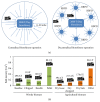Current challenges in commercially producing biofuels from lignocellulosic biomass
- PMID: 25937989
- PMCID: PMC4393053
- DOI: 10.1155/2014/463074
Current challenges in commercially producing biofuels from lignocellulosic biomass
Abstract
Biofuels that are produced from biobased materials are a good alternative to petroleum based fuels. They offer several benefits to society and the environment. Producing second generation biofuels is even more challenging than producing first generation biofuels due the complexity of the biomass and issues related to producing, harvesting, and transporting less dense biomass to centralized biorefineries. In addition to this logistic challenge, other challenges with respect to processing steps in converting biomass to liquid transportation fuel like pretreatment, hydrolysis, microbial fermentation, and fuel separation still exist and are discussed in this review. The possible coproducts that could be produced in the biorefinery and their importance to reduce the processing cost of biofuel are discussed. About $1 billion was spent in the year 2012 by the government agencies in US to meet the mandate to replace 30% existing liquid transportation fuels by 2022 which is 36 billion gallons/year. Other countries in the world have set their own targets to replace petroleum fuel by biofuels. Because of the challenges listed in this review and lack of government policies to create the demand for biofuels, it may take more time for the lignocellulosic biofuels to hit the market place than previously projected.
Figures







References
-
- Naik S. N., Goud V. V., Rout P. K., Dalai A. K. Production of first and second generation biofuels: a comprehensive review. Renewable and Sustainable Energy Reviews. 2010;14(2):578–597. doi: 10.1016/j.rser.2009.10.003. - DOI
-
- Demirbas A. Biofuels securing the planet’s future energy needs. Energy Conversion and Management. 2009;50(9):2239–2249. doi: 10.1016/j.enconman.2009.05.010. - DOI
-
- Jones D. S. J., Pujadó P. R. Handbook of Petroleum Processing. New York, NY, USA: Springer; 2006.
-
- REN21-Renewable Energy Policy Network for the 21st century, http://www.ren21.net/REN21Activities/GlobalStatusReport.aspx.
Publication types
LinkOut - more resources
Full Text Sources
Other Literature Sources
Molecular Biology Databases
